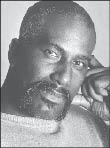 |
|
David Lewis |
David Lewis, 54, a towering figure in prisoner and addiction rehabilitation in his hometown of East Palo Alto, Calif., and across the country, was shot to death during an altercation in an upscale shopping center in nearby San Mateo on June 9. He was the second California anti-gang worker to be gunned down in the state in four months.
Lewis, who starting at 19 was in and out of California maximum security prisons over the next 17 years for armed robbery and drug crimes, came to national attention when he was part of a Bill Moyers documentary about the addiction recovery program Circle of Recovery. From there, he went on to found a nonprofit drug therapy program, Free at Last, which, according to its website, serves about 4,200 people a year, both youths and adults.
At 6-foot-5, with a white handlebar mustache and a shaved head, Lewis earned his living working for San Mateo County as an AIDS outreach worker. And it was on the streets where he was best known.
At the time he opened Free at Last, East Palo Alto had earned the title of Murder Capital of the United States, based on its homicide rate. Lewis spent years working the streets, where he had been a member of the Crips, to mediate disputes between gangs.
Ironically, he is the only East Palo Alto resident to have been killed this year.
At a memorial service for Lewis on June 20, colleagues and men who credited Lewis with turning around their lives remembered how he was always on the scene trying to keep trouble from erupting or to learn why trouble had broken out.
He was eulogized by the county’s former medical examiner, David Israelski, who is a Stanford University professor of medicine, and East Palo Alto Police Chief Ron Davis, who said Lewis had taught him that “everyone deserves a second chance.”
In demand as a speaker and often called upon to lead workshops on how to work the streets to help addicts and ex-convicts, Lewis was honored repeatedly for his work. He received the California Wellness Foundation’s Peace Prize in 1995.
Lewis credited his change of lifestyle to the 1989 Loma Prieta earthquake that rattled his San Quentin jail cell and brought down part of the Bay Bridge. He later said he decided he did not want to die alone in a cage, and worried about his four children.
When he was released from prison about two months later, he vowed to change his ways. But soon after, he was found by his parole officer lying in some bushes, a needle still in his arm from a heroin injection. The parole officer got him into a rehabilitation program, the Circle of Recovery.
San Mateo police first described the shooting of Lewis as “targeted,” but the police chief later said it could have been a chance encounter or the shooter could have been someone who followed him. Police are using surveillance video from the shopping mall and parking garage where he was shot once in the back. No one has been arrested in his death.
Earlier this year, on Super Bowl Sunday, Ronald LaMonte Barron, 40, of Los Angeles, who for two decades had worked on the streets – most recently for 10 years as a gang intervention worker with James Brown’s Amer-I-Can program – was shot multiple times when he emerged from a local restaurant after watching the game and interrupted a youth tagging the restaurant’s wall.
Police said after the Feb. 7 shooting that Barron, known as “Looney,” had asked the tagger to drop his paint can just before he was shot. The graffiti the tagger was spray-painting read “W/S CAE LS” which stands for “Catching all Enemies” or “Chasing All Enemies.”
A 16-year-old, who police said is not a gang member, was arrested a day later.






























